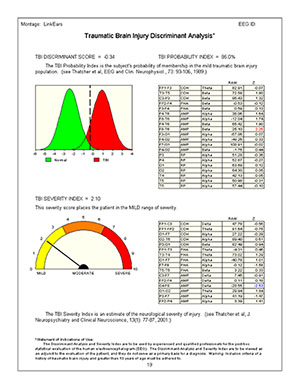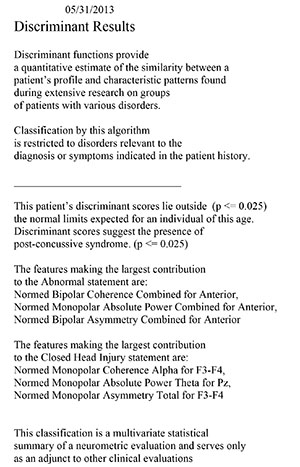Post-concussion Syndrome Treatment Program
Since 1995, we at the Scottsdale Neurofeedback Institute in Arizona have been offering a successful and alternative treatment program for individuals experiencing Post-concussion Syndrome (PCS) or Traumatic Brain Injury (TBI). The clinic primarily uses
QEEG brain map based EEG Neurofeedback training to achieve our remarkable success rate when treating head injuries.
Head injuries are very common and 20 to about 30% of Americans have experienced one or more. Usually the brain is able to heal itself significantly and little damage is done. But all too often the injury is more severe or there have been repeated head injuries and deficits in cognitive functioning remain. A loss of consciousness usually means a concussion has occurred, but one can have a concussion without a loss of consciousness. Concussions can also occur from repeated blows to the head that do not appear to be injuries at all, for instance heading the ball in soccer, repeated falls during skate boarding and blows to the head in basketball and football.
Concussions can cause problems in a wide variety of areas such as;
|
|
|
- Mood swings, irritability, short temper
|
|
|
|
|
|
|
|
|
|
|
|
|
|
When problems such as these persist after 6-12 months it is wise to seek further evaluation and treatment.
Post-concussion Syndrome Assessment
Testing can help in the assessment. These are very accurate computerized tests to assess visual and auditory attention, impulsivity, reaction time, memory, auditory processing etc. to determine if there are any significant gaps between IQ and performance.
QEEG topographic Brain Maps also can accurately assess for impairments in brain functioning and can assist greatly in determining if a concussion or traumatic brain injury has occurred.
QEEG Brain Mapping Research for Post-concussion Syndrome
The first step is performing a QEEG topographic brain map which is painless and non-invasive is that we place a cap with 19 electrodes on the scalp which picks up the brain electricity (EEG). The recorded EEG is processed through six normative databases including the New York University Medical School Normative Database. The statistical data will demonstrate which abnormalities are present and the degree of severity. Concussions have very distinctive patterns and two databases include “discriminant analysis” when the patients EEG is compared to individuals with known concussions. We typically find a combination of the following variables;
- Decrease in Alpha and Beta Relative Power
|
- Decrease in Alpha and Beta mean frequencies
|
- Increase in Temporal Lobe Slowing (Delta, Theta or Alpha)
|
- Significant Alpha Asymmetries
|
- Significant coherence and/or phase issues either hypo or hyper with phase lag usually being slower
|
- Temporal Lobe or all Frontal Lobe or Front/Back issues
|
- Excessive Delta and Theta (Recent Injury)
|
- More power in faster Alpha bands, 10 – 11 Hz (older injury)
|
QEEG Brain Map Head Injury Discriminants
Concussions have very distinctive EEG patterns and two databases include “discriminant analysis” when the patients EEG is compared to individuals with known concussions. Below is a positive example from each of these databases;
Traumatic Brain Injury

Post-Concussive Syndrome

These issues are often found to be significantly remediated in most with EEG neurofeedback training.
We now have 19 channel EEG neurofeedback systems that enable us to train all of the above variables. 19 electrodes are placed on the scalp and the recorded EEG is compared to the on board databases 128 times per second. The patient receives real-time multimedia feedback and is able to gradually move abnormal variables towards the normal range. As brain dysfunction becomes normalized they drop out of the feedback and the feedback focuses on the remaining abnormalities.
Re-mapping and/or re-testing confirm remarkable improvements. Research has demonstrated that these changes are almost always lasting. Although a large majority benefit significantly, not everyone responds to the treatment and people respond to different degrees. This is “training”, the patient has to make an effort to pay attention and learn.
We have been very impressed with the results for the great majority of those treated. Some report they are doing better overall after neurofeedback than before the head injury, partly because we have also treated co-existing disorders such as ADHD, mood disorders such as depression, anxiety, and learning disabilities.

